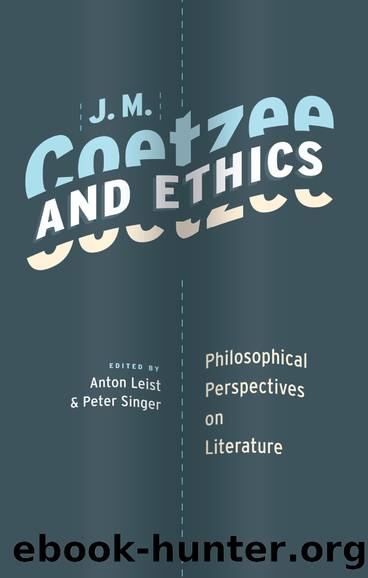J. M. Coetzee and Ethics by Anton Leist

Author:Anton Leist
Language: eng
Format: epub
Tags: Nature/Animal Rights
Publisher: Columbia University Press
Published: 2011-10-11T16:00:00+00:00
BARBARIANS: THROUGH TORTURE TO UNDERSTANDING
As already stated, divergent positions are bound together under the label of experimental postmodernists. Besides the “archaic” postmodernists we could also distinguish the “pragmatist” ones. Both take for granted some basic elements of human life. As opposed to the archaics, the pragmatists accept aspects of the “modern” liberal culture among these elements, whereas archaic postmodernists call into question reflection and words themselves. Given this distinction, Life and Times is obviously nearer the archaic than the pragmatist position. There is a slightly different attitude involved in Coetzee’s earlier Waiting for the Barbarians, and a look at this book may prove helpful to giving the distinction a clearer profile. The book shares its title with a 1904 poem by the Greek poet Constantine Cavafy that depicts a situation of both fear and the hope of salvation by the decadent Romans against threatening barbarians.12
Coetzee’s story centers in the same way around a morally corrupt “Empire” waging war against nomadic aborigines, who themselves in part represent standards of natural good but above all become the object of imperial power enacted in different shades of evil. If the Empire represents Western culture at its worst, the story’s narrator, the elderly magistrate of a little border town, embodies Western attitudes in a more favorable way. In contrast to Michael K, the Magistrate undergoes a development for the better and, refined through both brutal events and especially the ordeal of being tortured himself, ends up a more understanding person than he was at the beginning. Judged from the standpoint of Barbarians (1980), one could think of the unreservedly negative lesson of Life and Times as perhaps being attributable to the aggravated circumstance of actual history, the politically sharpened situation in the South Africa of 1983. But in Barbarians, too, it is not entirely clear on which side of my distinction between “archaic” and “pragmatic” the figure of the Magistrate should finally be placed.
Overall, as mentioned, the story concerns the self-improvement of the central figure, the Magistrate.13 Why does he need improvement? At the beginning of the story he does not “ask for more than a quiet life in quiet times,” “serving out [his] days on this lazy frontier, waiting to retire” (Barbarians, 8). He is content to have created as comfortable a life as possible for himself, and if he shirks cruelties and conflicts it is because of his own laziness. He shuts his ears to the screams of the victims. As he becomes increasingly involved in the imprisonment and torture of some of the native people, though, he is being captured by his own obsession with torture, manifested in his strange attitude of bodily obsession toward a barbarian girl. This shows itself in his attraction to the girl’s marks of torture, in his fits of self-reproach and doubtful self-reflection, and in the changing contents of his one recurrent dream. Opening himself gradually to the extent of his involvement in cruelties, he half-intentionally provokes his own torture, which provides the purgatorial event necessary to understand what it means to be repressed.
Download
This site does not store any files on its server. We only index and link to content provided by other sites. Please contact the content providers to delete copyright contents if any and email us, we'll remove relevant links or contents immediately.
The Lonely City by Olivia Laing(4111)
Animal Frequency by Melissa Alvarez(3750)
All Creatures Great and Small by James Herriot(3506)
Walking by Henry David Thoreau(3227)
Exit West by Mohsin Hamid(3173)
Origin Story: A Big History of Everything by David Christian(3133)
COSMOS by Carl Sagan(2944)
How to Read Water: Clues and Patterns from Puddles to the Sea (Natural Navigation) by Tristan Gooley(2849)
Hedgerow by John Wright(2771)
The Inner Life of Animals by Peter Wohlleben(2763)
Origin Story by David Christian(2677)
How to Read Nature by Tristan Gooley(2657)
Project Animal Farm: An Accidental Journey into the Secret World of Farming and the Truth About Our Food by Sonia Faruqi(2654)
How to Do Nothing by Jenny Odell(2640)
A Forest Journey by John Perlin(2583)
Water by Ian Miller(2579)
The Plant Messiah by Carlos Magdalena(2451)
A Wilder Time by William E. Glassley(2358)
Forests: A Very Short Introduction by Jaboury Ghazoul(2331)
